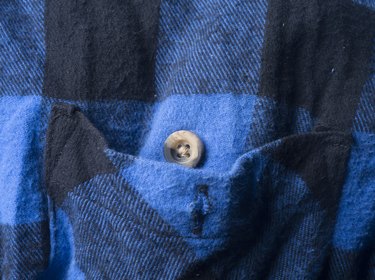
Theoretically, flannel gets better with age. Maybe you have an ancient flannel shirt hanging in your closet that's been washed so many times it's as soft as a baby's skin. However, for every butter-soft flannel shirt in your closet, you probably also have a set of flannel sheets that are so rough and pilled that you save them for emergencies only. Once flannel has taken on that nubby texture, there's not much you can do to reverse it, so the key to keeping flannel soft is to wash it the right way every time, starting with the very first wash.
Why Are My Flannel Sheets Pilling?
Video of the Day
There are a few reasons flannel may start to feel rougher and nubbier the older it gets. Improper laundering is one reason. Pilling is the other. Pilling happens when small fibers break and tangle into small balls on the surface of the fabric. It can occur in many kinds of fabric, but flannel is especially susceptible to it.
Video of the Day
With flannel sheets, pilling can develop quickly from friction with your body and pajamas as you move around in bed, and it gets worse when the sheets are washed. Some amount of pilling is unavoidable with flannel. Flannel sheets pilling is not necessarily a sign of low-quality fabric.
Flannel can be made of different kinds of fibers, including wool, but most of the flannel we buy and wear today is made of cotton. Flannel shirts, for example, are generally cotton flannel. Because flannel fabrics can be composed of different fiber blends, it's always advisable to check the care instructions for your specific items.
How to Wash Flannel
The more flannel rubs against itself, the more pilling will occur. So, the goal with washing is to agitate the fabric as little as possible. This means hand washing it or washing flannel on your machine's gentle cycle. If you're washing a set of flannel sheets, don't put any other fabrics in with them to minimize friction.
Use cool or warm water to wash flannel with mild detergent. Never use hot water to wash flannel, especially cotton flannel. As with other cotton fabrics, flannel may shrink when it's exposed to high heat.
Don't use any detergents containing bleach or liquid fabric softener on flannel fabrics. It may be counterintuitive, but using fabric softener on flannel can actually make it feel rougher. The fabric softener will coat the fibers and not wash away entirely. To actually soften flannel, pour about 1/2 cup of white vinegar into the washer while it's filling with water. Vinegar is an effective natural fabric softener that won't leave a stiff residue on flannel.
How to Dry Flannel
If possible, air dry flannel clothing and sheets so they can avoid the agitation that happens inside your dryer. If that's not possible, tumble dry flannel with your dryer's no-heat or low-heat setting.
Don't add dryer sheets to a load of flannel sheets or clothing. Just like liquid fabric softener, dryer sheets may leave a stiff residue on dry flannel. Do add wool or plastic dryer balls. They bounce around the dryer as it tumbles to keep fabric from clumping and rubbing against itself, which may help control pilling. The movement of the balls also helps to reduce static cling, which can be a problem with flannel.
Don't iron flannel if you can avoid it. If you have a flannel shirt that's hopelessly wrinkled, turn it inside out and start pressing with your iron on a cool setting. Gradually turn up the heat until the iron is just hot enough to eliminate wrinkles or toss a flannel shirt in the dryer on medium heat for a few minutes to release wrinkles.